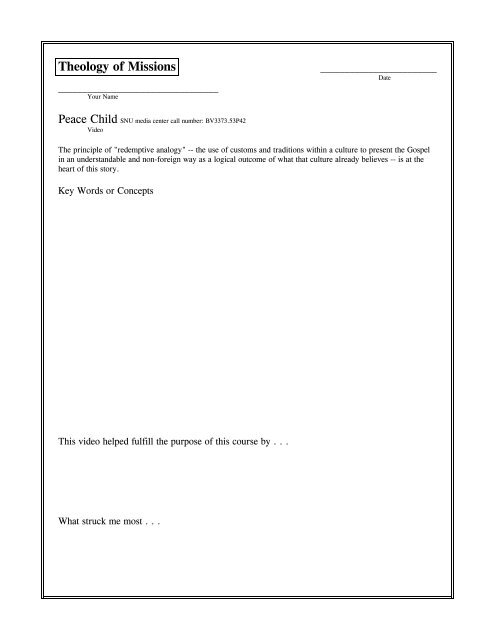Peace Child
Peace Child
Peace Child
Create successful ePaper yourself
Turn your PDF publications into a flip-book with our unique Google optimized e-Paper software.
Theology of Missions ________________________<br />
Date<br />
_________________________________<br />
Your Name<br />
<strong>Peace</strong> <strong>Child</strong> SNU media center call number: BV3373.53P42<br />
Video<br />
The principle of "redemptive analogy" -- the use of customs and traditions within a culture to present the Gospel<br />
in an understandable and non-foreign way as a logical outcome of what that culture already believes -- is at the<br />
heart of this story.<br />
Key Words or Concepts<br />
This video helped fulfill the purpose of this course by . . .<br />
What struck me most . . .
For centuries, the Sawi lived as cannibal-headhunters, each Sawi village warring<br />
with the others. Ordinary murder was nothing to them. To be a "legend maker", you had<br />
to create a special scenario in which you pretend to make peace with someone, then kill<br />
him when his guard is down. This Sawi ideal is called "tuwi asonai man" which means "to<br />
fatten with friendship for unexpected slaughter" as one would fatten a pig. When<br />
missionary Don Richardson told the Sawis the story of Jesus, to his disappointment they<br />
brightened at the account of Judas' betrayal of Jesus. To them, Judas was a super-Sawi<br />
and the hero of the biblical account.<br />
Because of dangerous, ongoing tribal warfare in the area, Richardson and his wife<br />
finally decided to leave the Sawi area even though they hadn’t found the key to effectively<br />
announcing the Gospel there. Distressed at losing their source of such things as modern<br />
medicine and steel axes, the warriors said they would make peace.<br />
Because the Sawis idealize treachery, Richardson wondered if there could be a<br />
guaranteed real peace. Then he found out that the one guarantee the Sawi would honor was<br />
an exchange of infants between villages. An exchanged infant was a "Tarop Tim" or<br />
"<strong>Peace</strong> <strong>Child</strong>". As long as the <strong>Peace</strong> <strong>Child</strong> lived, peace was guaranteed. That’s the kind of<br />
key idea or redemptive analogy which Richardson had been looking for. He saw that Jesus<br />
could be proclaimed as God's <strong>Peace</strong> <strong>Child</strong> who will never die and who therefore could<br />
guarantee everlasting peace.<br />
When first published, the book <strong>Peace</strong> <strong>Child</strong> created quite a stir. It even became the<br />
Book Section of an issue of Reader's Digest. The book covers in detail many topics not<br />
shown in this brief half-hour video. Sawi culture was full of customs disgusting even to the<br />
Sawi themselves. One person could impose his will on another by means of a "waness"<br />
bind. Closely related to the "waness" bind was the practice of "gefam ason," a mourning<br />
ritual practiced over dead bodies of relatives. And Sawi boys were deliberately raised not<br />
to obey their fathers. Fathers knew that this "discipline in reverse" would create violent,<br />
strong-willed men who would beat their wives, bristle at every real or imagined injustice,<br />
and be ready to go to war at a moment's notice.<br />
Sawi tradition also contained prophecies that someday the Words of "Remon"<br />
[Regeneration / Immortality] would come to them. Richardson realized that the revolting<br />
customs the Sawi practiced could be a sincere attempt to reach the fullest measure of<br />
collective sorrow so that the Words of Remon would come more quickly. Therefore, for<br />
those who believed that Richardson's message was in fact the Words of Remon, the old<br />
customs became unnecessary -- an old covenant that was now supplanted by a new one.<br />
The principle of preserving everything that is good and valuable in another person's<br />
culture, and of finding keys within that culture to make the Gospel more understandable is<br />
Biblical. The Apostle Paul often quoted Greek authors as a means of bridging cultural gaps<br />
or of just "fitting in". At Mars' Hill Paul quoted or alluded to Aeschylus' Eumenides,<br />
Plato's Republic and Plato's Phaedo, as well as Epimenides, Aratus and Euripides. By<br />
knowing -- and by showing that he knew -- what his hearers already believed, he was able<br />
to lead them from familiar concepts to unfamiliar ones. In Acts 21:39, moments after being<br />
nearly killed by a mob, Paul got a Roman officer's attention by quoting Euripides (using<br />
the phrase "no mean city"). In his letter to Titus, Paul quoted Epimenides of Knossos, a<br />
Cretian who had unflattering but true things to say about his own countrymen.

















